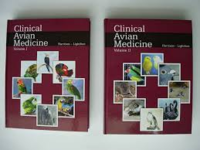
Avian Medicine: Principles and Applications
Avian Medicine: Principles and Applications
Ritchie, Harrison and Harrison
This highly regarded was developed to provide a definitive reference text that blends the science of health with the art of clinical medicine.
By applying the information presented in the book, the competent avian practitioner will be able to effectively provide the highest quality care for his patients and guide the companion bird client or aviculturist in implementing and effective preventative health programme. Less experienced practitioners can learn basic evaluation, support and surgical techniques while developing an expanded understanding of advanced procedures that can be performed by specialists in avian medicine and surgery.
Avian Medicine: Principles and Application is the essential reference and the most comprehensive why to, when to and how to guide for companion and aviary bird management, medicine and surgery.
These are printable .pdf's: Click here to download Adobe Acrobat Reader® for free
- CONTENTS
- ACKNOWLEGEMENTS/FORWARD
- PROLOGUE
- PREFACE
- Chapter 1: The Avian Patient
- Chapter 2: The Avian Flock
- Chapter 3: Nutrition
- Chapter 4: Perspective on Parrot Behavior
- Chapter 5: Defense Mechanisms of the Avian Host
- Chapter 6: Future Preventive Medicine
- Chapter 7: Practice Dynamics
- Chapter 8: Making Distinctions in the Physical examination
- Chapter 9: Hematology
- Chapter 10: Cytology
- Chapter 11: Biochemistries
- Chapter 12: Imaging Techniques
- Chapter 13: Endoscopic Examinations and Biopsy Techniques
- Chapter 14: Necropsy Examination
- Chapter 15: Supportive Care and Emergency Therapy
- Chapter 16: Trauma Medicine
- Chapter 17: Antimicrobial Therapy
- Chapter 18: Formulary
- Chapter 19: Gastroenterology
- Chapter 20: Hepatolgy
- Chapter 21: Nephrology
- Chapter 22: Pneumonolgy
- Chapter 23: Endocrinolgy
- Chapter 24: Dermatolgy
- Chapter 25: Oncology
- Chapter 26: Ophthamology
- Chapter 27: Cardiology
- Chapter 28: Neurology
- Chapter 29: Theriogenology
- Chapter 30: Neonatology
- Chapter 31: Malnutrition
- Chapter 32: Viruses
- Chapter 33: Bacteria
- Chapter 34: Chlamydia
- Chapter 35: Mycoses
- Chapter 36: Parasites
- Chapter 37: Toxins
- Chapter 38: Mycoplasma and Rickettesia
- Chapter 39: Anesthesiology
- Chapter 40: Surgical Considerations
- Chapter 41: Soft Tissue Surgery
- Chapter 42: Orthopedic Surgical Techniques
- Chapter 43: Passeriformes
- Chapter 44: Columbiformes
- Chapter 45: Galiformes
- Chapter 46: Ansriformes
- Chapter 47: Ramphastidae
- Chapter 48: Ratites
- INDEX

Clinical Avian Medicine
Greg Harrison, DVM, Dipl ABVP-Avian, Dipl ECAMS and Teresa Lightfoot, DVM, Dipl ABVP-Avian, have compiled the expertise and experience of 50 international contributing authors (and 50 reviewers) to produce an extraordinary two-volume reference, with over 1000 pages of text and over 1300 color images, for veterinarians and other avian health professionals.
The purpose of the book Clinical Avian Medicine is to provide some highlights of emerging thoughts, techniques and procedures that are currently being assimilated into avian practice.
These are printable .pdf's: Click here to download Adobe Acrobat Reader® for free
- Chapter 1: Clinical Practice
- Chapter 2: Companion Bird
- Chapter 3: Concepts in Behavior I
- Chapter 4: Nutrition I
- Chapter 4: Nutrition II
- Chapter 5: Calcium
- Chapter 6: Physical Examination
- Chapter 7: Emergency and Critical Care
- Chapter 8: Pain Management
- Chapter 9: Therepeutic Agents
- Chapter 10: Integrative Medicine
- Chapter 11: Low Risk Pest Management
- Chapter 12: Cardiology
- Chapter 13: Integument
- Chapter 14: Gastrointenstinal
- Chapter 15: Evaluating and Treating the Liver
- Chapter 16: Evaluating and Treating the Kidneys
- Chapter 17: Evaluating and Treating the Nervous System
- Chapter 18: Evaluating and Treating the Reproductive System
- Chapter 19: Endocrine Considerations
- Chapter 20: Overview of Tumors
- Chapter 21: Preventive Medicine
- Chapter 22: Diagnostic Value of Hematology
- Chapter 23: Diagnostic Value of Biochemistry
- Chapter 24: Diagnostic Value of Endoscopy and Biopsy
- Chapter 25: Advances in Diagnostic Imaging
- Chapter 26: Diagnostic Value of Necropsy
- Chapter 27: Update on Chlamydophila psittaci
- Chapter 28: Implications of Mycobacteria in Clinical Disorders
- Chapter 29: Implications of Mycosis in Clinical Disorders
- Chapter 30: Implications of Macrorhabdus in Clinical Disorders
- Chapter 31: Implications of Toxic Substances in Clinical Disorders
- Chapter 32: Implications of Viruses in Clinical Disorders
- Chapter 33: Updates in Anesthesia and Monitoring
- Chapter 34: Surgical Resolution of Orthopedic Disorders
- Chapter 35: Surgical Resolution of Soft Tissue Disorders (A)
- Surgical Resolution of Soft Tissue Disorders (B)
- Surgical Resolution of Soft Tissue Disorders (C)
- Surgical Resolution of Soft Tissue Disorders (D)
- Chapter 36: Management of Waterfowl
- Chapter 37: Management of Racing Pigeons
- Chapter 38: Management of Galliformes
- Chapter 39: Management of Canaries, Finches and Mynahs
- Chapter 40: Management of Raptors (A)
- Management of Raptors (B)
- Chapter 41: Management of Captive Ratites
- Chapter 42: Management of Zoos and Park Birds
- Appendix
Last edited:








